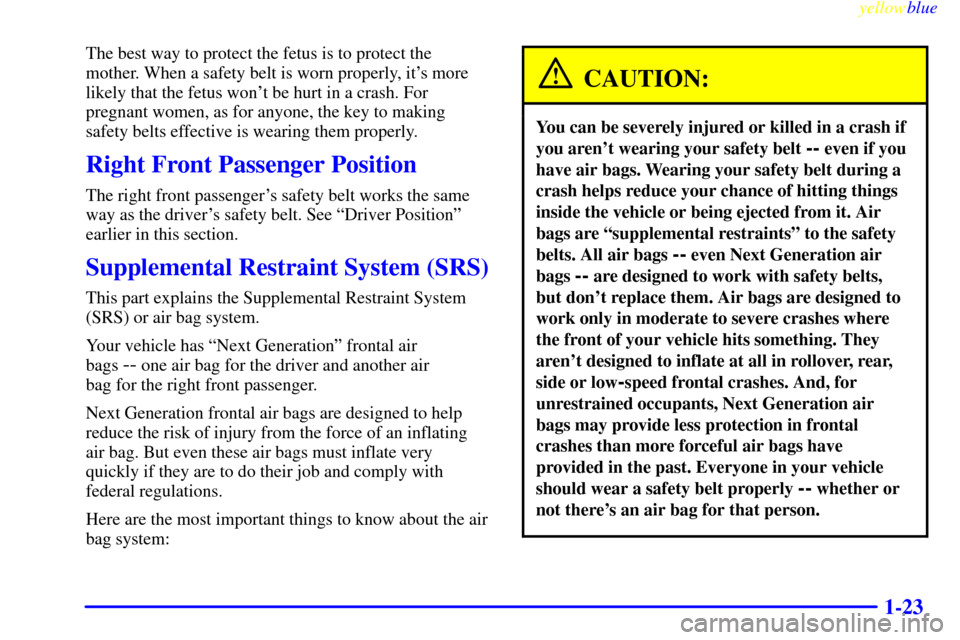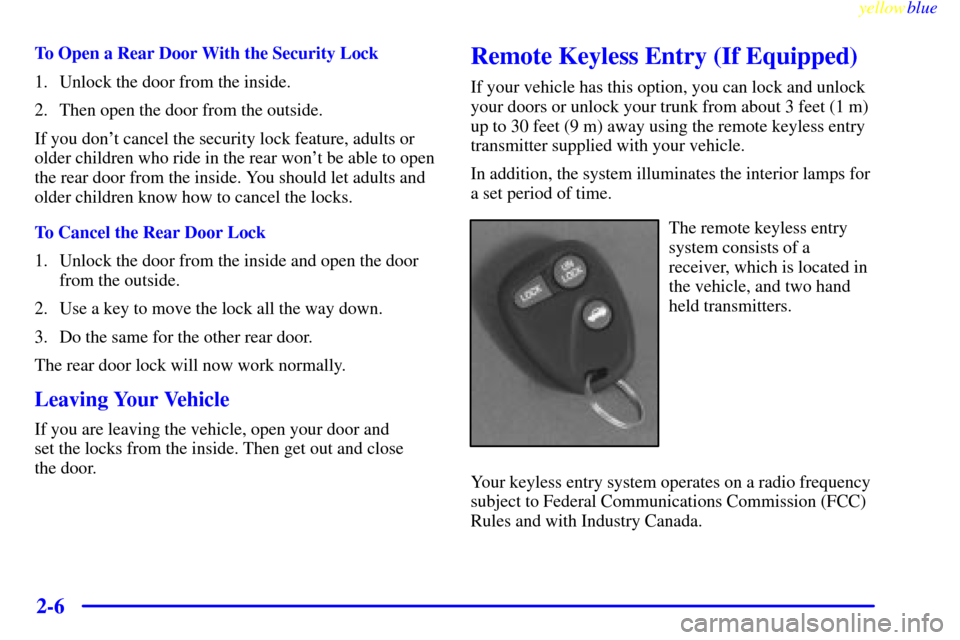Page 31 of 368

yellowblue
1-23
The best way to protect the fetus is to protect the
mother. When a safety belt is worn properly, it's more
likely that the fetus won't be hurt in a crash. For
pregnant women, as for anyone, the key to making
safety belts effective is wearing them properly.
Right Front Passenger Position
The right front passenger's safety belt works the same
way as the driver's safety belt. See ªDriver Positionº
earlier in this section.
Supplemental Restraint System (SRS)
This part explains the Supplemental Restraint System
(SRS) or air bag system.
Your vehicle has ªNext Generationº frontal air
bags
-- one air bag for the driver and another air
bag for the right front passenger.
Next Generation frontal air bags are designed to help
reduce the risk of injury from the force of an inflating
air bag. But even these air bags must inflate very
quickly if they are to do their job and comply with
federal regulations.
Here are the most important things to know about the air
bag system:
CAUTION:
You can be severely injured or killed in a crash if
you aren't wearing your safety belt
-- even if you
have air bags. Wearing your safety belt during a
crash helps reduce your chance of hitting things
inside the vehicle or being ejected from it. Air
bags are ªsupplemental restraintsº to the safety
belts. All air bags
-- even Next Generation air
bags
-- are designed to work with safety belts,
but don't replace them. Air bags are designed to
work only in moderate to severe crashes where
the front of your vehicle hits something. They
aren't designed to inflate at all in rollover, rear,
side or low
-speed frontal crashes. And, for
unrestrained occupants, Next Generation air
bags may provide less protection in frontal
crashes than more forceful air bags have
provided in the past. Everyone in your vehicle
should wear a safety belt properly
-- whether or
not there's an air bag for that person.
Page 37 of 368

yellowblue
1-29
If your vehicle ever gets into a lot of water -- such as
water up to the carpeting or higher
-- or if water enters
your vehicle and soaks the carpet, the air bag controller
can be soaked and ruined. If this ever happens, and then
you start your vehicle, the damage could make the air bags
inflate, even if there's no crash. You would have to replace
the air bags as well as the sensors and related parts. If your
vehicle is ever in a flood, or if it's exposed to water that
soaks the carpet, you can avoid needless repair costs by
turning off the vehicle immediately and disconnecting the
battery cables. Don't let anyone start the vehicle under any
circumstances. See your dealer for service.
Servicing Your Air Bag-Equipped Vehicle
Air bags affect how your vehicle should be serviced.
There are parts of the air bag system in several places
around your vehicle. You don't want the system to
inflate while someone is working on your vehicle. Your
dealer and the Cavalier Service Manual have
information about servicing your vehicle and the air bag
system. To purchase a service manual, see ªService and
Owner Publicationsº in the Index.
CAUTION:
For up to 10 minutes after the ignition key is
turned off and the battery is disconnected, an air
bag can still inflate during improper service. You
can be injured if you are close to an air bag when
it inflates. Avoid yellow connectors. They are
probably part of the air bag system. Be sure to
follow proper service procedures, and make sure
the person performing work for you is qualified
to do so.
The air bag system does not need regular maintenance.
Rear Seat Passengers
It's very important for rear seat passengers to buckle up!
Accident statistics show that unbelted people in the rear
seat are hurt more often in crashes than those who are
wearing safety belts.
Rear passengers who aren't safety belted can be thrown
out of the vehicle in a crash. And they can strike others
in the vehicle who are wearing safety belts.
Page 65 of 368

2-
yellowblue
2-1
Section 2 Features and Controls
Here you can learn about the many standard and optional features on your vehicle, and information on starting,
shifting and braking. Also explained are the instrument panel and the warning systems that tell you if everything is
working properly
-- and what to do if you have a problem.
2
-2 Keys
2
-4 Door Locks
2
-6 Remote Keyless Entry (If Equipped)
2
-11 Theft
2
-12 Passlock�
2-13 New Vehicle ªBreak-Inº
2
-13 Ignition Positions
2
-16 Starting Your Engine
2
-18 Engine Coolant Heater (If Equipped)
2
-20 Automatic Transaxle Operation
2
-25 Manual Transaxle Operation
2
-28 Parking Brake
2
-29 Shifting Into PARK (P)
(Automatic Transaxle Only)
2
-31 Shifting Out of PARK (P)
(Automatic Transaxle Only)
2
-31 Parking Your Vehicle
(Manual Transaxle Models Only)2
-32 Parking Over Things That Burn
2
-32 Engine Exhaust
2
-33 Running Your Engine While You're Parked
(Automatic Transaxle)
2
-34 Windows
2
-35 Tilt Wheel (If Equipped)
2-35 Turn Signal/Multifunction Lever
2-41 Exterior Lamps
2
-44 Interior Lamps
2
-46 Mirrors
2
-47 Storage Compartments
2
-47 Ashtrays and Cigarette Lighter (If Equipped)
2
-48 Sun Visors
2
-49 Sunroof (If Equipped)
2
-49 Convertible Top (If Equipped)
2
-60 The Instrument Panel -- Your
Information System
2
-62 Instrument Panel Clusters
2
-65 Warning Lights, Gages and Indicators
Page 66 of 368
yellowblue
2-2
Keys
CAUTION:
Leaving children in a vehicle with the ignition
key is dangerous for many reasons. A child or
others could be badly injured or even killed.
They could operate power windows or other
controls or even make the vehicle move. Don't
leave the keys in a vehicle with children.
Page 67 of 368
yellowblue
2-3
One key is used for the
ignition, the doors and all
other locks.
When a new vehicle is delivered, the dealer removes the
key tag from the key, and gives it to the first owner.
Each tag has a code on it that tells your dealer or a
qualified locksmith how to make extra keys. Keep the
tag in a safe place. If you lose your key, you'll be able to
have a new one made easily using the tag.If you need a new key, contact your Chevrolet dealer
who can obtain the correct key code. In an emergency,
call the Chevrolet Roadside Assistance Program at
1
-800-CHEV-USA� (1-800-243-8872). In Canada call
1
-800-268-6800.
NOTICE:
Your vehicle has a number of new features that
can help prevent theft. But you can have a lot of
trouble getting into your vehicle if you ever lock
your key inside. You may even have to damage
your vehicle to get in. So be sure you have an
extra key.
Page 68 of 368
yellowblue
2-4
Door Locks
CAUTION:
Unlocked doors can be dangerous.
Passengers -- especially children -- can easily
open the doors and fall out. When a door is
locked, the inside handle won't open it.
Outsiders can easily enter through an unlocked
door when you slow down or stop your vehicle.
This may not be so obvious: You increase the
chance of being thrown out of the vehicle in a
crash if the doors aren't locked. Wear safety belts
properly, lock your doors, and you will be far
better off whenever you drive your vehicle.
There are several ways to lock and unlock your vehicle.
Use your key to unlock your vehicle from the outside.
You can also use the optional remote keyless entry
system to unlock your vehicle. See ªRemote Keyless
Entry Systemº in the Index.
To lock the door from the
inside, push the locking
lever forward.
To unlock the door, pull the locking lever backward.
Page 69 of 368
yellowblue
2-5 Power Door Locks (If Equipped)
You can lock or unlock all
doors of your vehicle from
the driver's or front
passenger's door lock
switch.
Push the lower portion of the switch to lock your doors.
Push the upper portion of the switch to unlock your doors.
The lever on each rear door works only that door's lock.
It won't lock (or unlock) all of the doors
-- that's a
safety feature.
Rear Door Security Lock (4-Door Models)
Your vehicle is equipped
with rear door security
locks that help prevent
passengers from opening
the rear doors of your
vehicle from the inside.
To Use One of These Locks
1. Use a key to move the lock all the way up.
2. Close the door.
3. Do the same thing to the other rear door lock.
The rear doors of your vehicle cannot be opened from
the inside when this feature is in use.
Page 70 of 368

yellowblue
2-6
To Open a Rear Door With the Security Lock
1. Unlock the door from the inside.
2. Then open the door from the outside.
If you don't cancel the security lock feature, adults or
older children who ride in the rear won't be able to open
the rear door from the inside. You should let adults and
older children know how to cancel the locks.
To Cancel the Rear Door Lock
1. Unlock the door from the inside and open the door
from the outside.
2. Use a key to move the lock all the way down.
3. Do the same for the other rear door.
The rear door lock will now work normally.
Leaving Your Vehicle
If you are leaving the vehicle, open your door and
set the locks from the inside. Then get out and close
the door.
Remote Keyless Entry (If Equipped)
If your vehicle has this option, you can lock and unlock
your doors or unlock your trunk from about 3 feet (1 m)
up to 30 feet (9 m) away using the remote keyless entry
transmitter supplied with your vehicle.
In addition, the system illuminates the interior lamps for
a set period of time.
The remote keyless entry
system consists of a
receiver, which is located in
the vehicle, and two hand
held transmitters.
Your keyless entry system operates on a radio frequency
subject to Federal Communications Commission (FCC)
Rules and with Industry Canada.